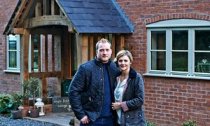 Self builders Hannah Jones and Theo Hodnett spent around £125, 000 on their new home.
Self builders Hannah Jones and Theo Hodnett spent around £125, 000 on their new home.
Hannah Jones, 25, and her fiancé, Theo Hodnett, 27, spent months looking for a home around the picturesque market town of Ludlow in Shropshire, but couldn’t find anything in their price range. “We were facing the prospect of renting indefinitely because we couldn’t afford to buy a house of our own and prices were only going up, ” says Jones, a sales and marketing assistant.
After an increasingly desperately search Hodnett, a carpenter, suggested a different approach. “His parents had just finished building their own home so he suggested that we could do it too. I’ve always wanted to build my own home. When I thought about it I started to get really excited, ” Jones says.
The couple put in a planning application with Shropshire council to build a house on land given to them by Hodnett’s parents near Richards Castle, a village just down the road from Ludlow. Two years later work began on their three-bedroom house and the building was completed last summer.
In all, they spent around £125, 000. They took out a £120, 000 self-build mortgage with the Halifax on a two-year fixed rate of 3.9%. They had to build the property to roof height before the first mortgage payment was released, which cost them around £28, 000. Self-build mortgages are typically released in four to six stages in arrears, after each stage is complete.
The finished house is now worth between £280, 000 and £300, 000, the couple estimate – or more than double what it cost them. They added environmentally friendly features such as a ground-source heat pump, and plan to install solar panels. Costs were kept down by doing some of the work themselves and shopping around for the materials.
“My dad and Theo worked on the house most evenings and weekends, while I helped with painting. We shopped around for things like the timber frame – the most expensive single item at £16, 000, ” says Jones.
“We could never have been able to buy a similar-sized house. We’ve also been incredibly lucky that there weren’t any major setbacks during the build. Now our friends are considering building their own homes, too.”
The couple took advantage of an innovative scheme run by Shropshire council which makes it easier for self-builders to secure planning permission. It is designed to boost the number of affordable homes in the region, waiving some planning restrictions if the builders agree to certain strict conditions.
But there is a catch. A clause in the planning permission stipulates that if they decide to sell, the property must be advertised as an “affordable home”, with the price capped at around 60% of its market value for the first six months on the market. At current prices, Jones and Hodnett would have to advertise their property for around £180, 000. In this initial period, only a buyer with a connection to the local area would be allowed to purchase it, subject to approval from the council. However, if no one comes forward after six months, these conditions would be relaxed.
There are also restrictions over the size of the property and how it can be expanded in the future to ensure it remains affordable for future buyers. “We plan on staying for a very long time, so we weren’t worried about the restrictions on the sale price, ” says Hodnett.
The couple hope to expand the property in the future. “It is already 100sq m but we hope that we will be able to add an extension, such as a conservatory, if we give the council a valid reason, such as having children.”
More than 400 people have applied to the Build Your Own Affordable Home scheme since it was originally launched by the South Shropshire borough council (now part of Shropshire council) in 2003, and 217 planning applications have been approved. Around four in five applications are from first-time buyers.
But is self-build really a solution for first-timers locked out of the property market?
Despite the popularity of television shows such as Grand Designs, appetite for self-build has slumped in recent years. This has been due to a mortgage lending drought in the wake of the credit crunch and ever-tighter planning rules, which have made it even harder to secure permission, according to Michael Holmes, spokesperson for the London Homebuilding & Renovating and Home Improvement Show.
“In the wake of the credit crunch, lenders decided that self-build mortgages were too risky and many of the bigger players pulled out. There has been some improvement since then, but it is still a very limited market, ” he said.










